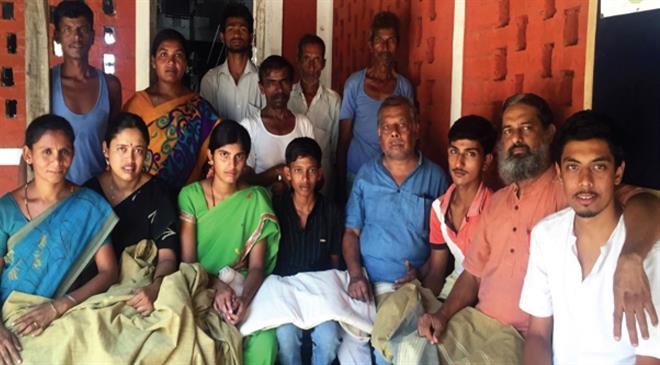Farming Fashion
Ananthasayanan, Aka Ananthoo, is one of the co-founders of Tula. Tula works with cotton farmers and helps them farm organically. The cotton is then procured, handspun, handwoven, dyed with natural dyes and manually stitched. Profits from the sale of garments are ploughed back into promoting livelihoods. Ananthoo shares with N Kalyani what went into the creation of Tula.
What is your work profile now at Tula?
My work specifically is to run! I run to ensure financial discipline and quick turnaround time for money, to ensure quality and quantity targets are met consistently, to make sure conversion to fabric and garments happens as per plan, to bring in more volunteers and hence designs too, and, finally, to ensure timely sales. Of course, all this is backed by a set of energised and passionate volunteers and colleagues. Another important aspect of Tula is about not just commoditising and selling, but spreading the concept and importance of such artisanal, handmade products, thus ensuring khadi or handloom is also duly respected.
What prompted you to take to promoting the organic way?
After we decided to quit our corporate jobs, my wife and I travelled around to assess the status of agriculture and plight of farmers. We were moved. There were also a few others like us who had quit their corporate jobs just then and were keen to help farmers. During our travels we found that sustainable agriculture-organic farming-was a better solution to most crises- ecological, economic, climate-related and human health. That is what pushed us to take to promoting the organic way.
You are a co-founder of Tula. Please tell us how the organisation came into being.
We began working with farmers and helped them go organic. We started a not-for-profit organic retail outlet 11 years back called Restore, (restore. org.in). Subsequently, we floated the OFM (Organic Farmers Market https:// www.ofmtn.in/) to take the organic produce to the middle class, thus running a series of collective stores as a distributor-retailer cooperative model.
Tula's roots emerged out of a revival of organic farming of indigenous foods. The project began in 2007 in Chennai, during a brainstorming session amongst friends, who wanted to address the agriculture and farmer crisis ravaging India through an environmentally and economically sustainable way.
It was the picture of cotton that was a sorry state of affairs. We were concerned with issues such as the condition of the farmer, use of chemical fertilisers and pesticides, costs of production, returns on investment, genetically modified crop varieties and availability of seeds. These issues became the basis for Tula to focus on reviving rain-fed desi cotton.
Organic clothing has become the need of the hour as much as understanding its ethical value chain, revival of khadi and promoting local livelihoods. Desi cotton was always accompanied by manual spinning and hand weaving of the most skilled and aesthetic kind making India world famous for its textiles. Even the world famous Dhaka muslin was woven with desi cotton.
So, a set of friends invested, through the crowdfunding model, and took up cotton growing to upgrade the value chain in an ethical and eco-friendly manner. Tula was set up to conduct the whole process, as a not-for-profit, ensuring all livelihoods in the value chain improved and were empowered. Tula can be viewed online at tula.org.in and facebook.com/tulaIndia.

How do the producers and creators of Tula products benefit?
The farmers, hand spinners (100 per cent women), hand weavers (50 per cent women), and dyers and tailors (again a large percentage of women) all benefit. Consciously, all are paid manifold compared to the going market rates, and it is ensured that they all get fair remuneration round the year.
When you buy a Tula garment worth ₹1,000, a sum of ₹100 (10%) goes to the cotton farmer, ₹130 (13%) towards spinning costs, ₹90 (9%) towards dyeing, ₹220 (22%) towards weaving, ₹60 (6%) towards design, ₹120 (12%) towards tailoring, ₹110 (11%) towards administration and transport, ₹70 (7%) against wastage in various stages, and only a slim margin of ₹100 (10%) to cover overheads. This distribution is based on the productivity of the players in earning a respectable livelihood.

How and where do you sell Tula clothing?
Tula has a full range of garments-menswear, womenswear, kidswear, sarees, lungis, towels, hankies, bedsheets, stoles and dupattas. We have fabric yardage for other designers to buy and finish as per their styles or for consumers / end-users to buy and convert to their liking. And yes, all of it is organic. The natural dyeing is also very special in that we use only natural mordants, not synthetic ones. Sales happen out of our flagship store at Chennai, and also through exhibitions, mostly organised through our network. These exhibition events are introduced with a presentation and talk, sharing our exploration, experiments and journey to date.
Tell us more about how the cotton sourced from rain-fed cotton plants is used to create the hand-spun and manually tailored apparel of Tula.
Tula works to revive and encourage the rich artisanal traditions of India and its rain-fed desi cotton. To help some of our farmers and artisans in dire need of support, fifteen like-minded friends decided to step in and make a difference by bringing a niche clothing line purely to revive rain-fed desi cotton, making sure everyone involved gets remunerated well enough so as to raise their lives from mere subsistence. We now have one of the most eco-friendly lines of garments and a light one too.
Each of the friends who came together invested ₹1 lakh, amounting to ₹15 lakh collectively, and they commenced the initiative. And a few of them are involved actively in the entire lifecycle to date.
At Tula our focus is on being sustainable, bringing together rainfed desi cotton farmers, skilled khadi spinners, master weavers, dyers who specialise in vegetable dyes, embroiderers, handblock printers, and such other workers as a decentralised model to create eco-friendly garments.
In order to minimise the carbon footprint and transport costs significantly, Tula follows a unique model of Cotton-to-Cloth within the respective states. For instance, when cotton is sourced from Karnataka, the spinning, dyeing and weaving are done in and around the state of Karnataka. Likewise, a similar system is also followed in Maharashtra. Tula emphasises on decently remunerating all farmers and artisans involved, and in a fair and timely manner. Tula attempts to create very light garments using rain-fed organic desi cotton that is then handspun, handwoven, naturally dyed and manually tailored.
What started with ₹15 lakh in Tamil Nadu in 2014, expanded to Karnataka and in the next year to Maharashtra, all with the same first investment. What started by touching 100 livelihoods is now touching 300, thus exhibiting a different model especially in terms of the per employment investment.

How do you price the products at Tula?
We claim these are the cheapest you can find, considering the values that go with it, in the market. It is deliberately priced aggressively so that more people, especially the middle class, can afford it. But it will be expensive than mill-made clothing because there will be a fair remuneration and no exploitation.
What has been the response to Tula?
The response has been fabulous. People have lapped it up. Word of mouth is our main mode of publicity. Our customers have felt the fabric, its breathing nature and how nice it feels on one's person. It is also the pride of having touched five livelihoods each time one sports a Tula outfit. We have sold stuff worth crores of rupees without having printed a single card or brochure to date, and without a single plastic cover.

How do you get the message of the benefits of being organic across?
Unlike food where there is an immediate connect, and benefit to appreciate and experience, clothing is not easily related to. We, however, keep sharing issues related to the pollution that is caused in mill-produced yarn, and in chemical dyeing (where rivers, groundwater, soil and air get polluted and human health is gravely affected), and the energy and water-consuming aspects of mill-produced cloth. Compare this to the ecologically and economically sustainable organic clothing which is something like slow clothing, akin to slow cooking, which is a boon. There is a good deal of awareness today, and one hopes that it increases with more discussion about it in the media, and from the people in general. And one wishes that the making of such clothing benefits the rural economy, farm livelihoods, biodiversity, environment, human health, and hence the nation as a whole.
What are your plans for Tula?
We wish more people get to know about this and support similar ventures, or at least part efforts like handloom or naturally dyed cloth even if those are not completely eco-friendly. We also dream of more replication. Many more such initiatives involving more and more groups of farmers, spinners and weavers are very much needed.





